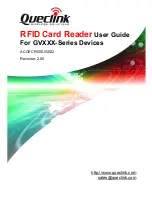
PRT-EM Series Readers fv 1.29 and 2.29 Rev. J.doc
2012-01-05
Page 24 from 59
6 .
P
R O G R A M M I N G
The PRT-EM can be programmed if following ways:
From the PC
From the keypad located on the main reader
From the keypad located on the external (secondary) reader
Through multiple reading of the so called
Programming Card
Preparing the Reader for Terminal Mode
If the unit is dedicated for
Terminal Mode
(slave operation), the only one programming step
which is required is programming of the required operating mode. It can be done either manually
during
Memory Reset
or remotely from PC.
Preparing the Reader for Standalone Mode
If the unit is dedicated for
Standalone Mode
(autonomic operation), installer must perform four
programming steps:
1.
Configuring the reader to either
Full
or
Simple Standalone Mode
and programming
MASTER and INSTALLER cards and/or PIN-s (
Memory Reset
)
2.
Configuring the reader for specific installation scenario (
Installer Programming
)
3.
Programming cards and PIN-s for the users (
User Programming
)
Alternatively, reader can be connected to PC and programmed entirely from the RARC program.
6.1.
P
ROGRAMMING THE
PRT-EM
R
EADERS WITHOUT
K
EYPAD
The PRT-EM readers which are not equipped with keypad can be programmed in three ways only:
From PC
By multiple readings of the so called
Programming Card
From the keypad located on the second (slave) reader
6.1.1.
Programming Through Multiple Readings of the Programming Card
Though some PRT-EM readers are not equipped with keypad they can be programmed locally
according to the same programming functions as readers with keypad. The difference in
programming is so that instead of pressing certain keys (like you normally do when programming
readers with keypad) you must emulate key pressing by multiple readings of the so called
Programming Card
. For example in order to emulate key [9] you must read
Programming Card
9-times (simply present it to the reader and take it back 9-times) and then wait approx. 3 seconds
for the reader to generate a confirmation signal (two beeps) which will mean that series of card
readings were accepted as an equivalent of a single key press and the reader is now waiting for the
next step of the programming procedure.
Use following cards as
Programming Cards
:
In the
Installer Programming
use INSTALLER card
in the
User Programming
use MASTER card
in the
Memory Reset
procedure use any proximity card
Key
Emulation Method
[1]..[9]
Read card [N]-times where [N] is equal to programmed digit
[0]
Read
Programming Card
10-times
[*]
Read
Programming Card
11-times
[#]
Read
Programming Card
12-times
Note: Each time you complete the sequence of multiple readings of the programming card
wait for the reader to generate confirmation signal (two beeps) which will confirm that
reader has accepted series of card readings as the equivalent of a single key press.
Summary of Contents for PRT12EM
Page 43: ...PRT EM Series Readers fv 1 29 and 2 29 Rev J doc 2012 01 05 Page 43 from 59...
Page 50: ...PRT EM Series Readers fv 1 29 and 2 29 Rev J doc 2012 01 05 Page 50 from 59...
Page 51: ...PRT EM Series Readers fv 1 29 and 2 29 Rev J doc 2012 01 05 Page 51 from 59...
Page 52: ...PRT EM Series Readers fv 1 29 and 2 29 Rev J doc 2012 01 05 Page 52 from 59...
Page 53: ...PRT EM Series Readers fv 1 29 and 2 29 Rev J doc 2012 01 05 Page 53 from 59...
Page 54: ...PRT EM Series Readers fv 1 29 and 2 29 Rev J doc 2012 01 05 Page 54 from 59...
Page 55: ...PRT EM Series Readers fv 1 29 and 2 29 Rev J doc 2012 01 05 Page 55 from 59...
Page 56: ...PRT EM Series Readers fv 1 29 and 2 29 Rev J doc 2012 01 05 Page 56 from 59...
Page 57: ...PRT EM Series Readers fv 1 29 and 2 29 Rev J doc 2012 01 05 Page 57 from 59...
Page 58: ...PRT EM Series Readers fv 1 29 and 2 29 Rev J doc 2012 01 05 Page 58 from 59...
















































